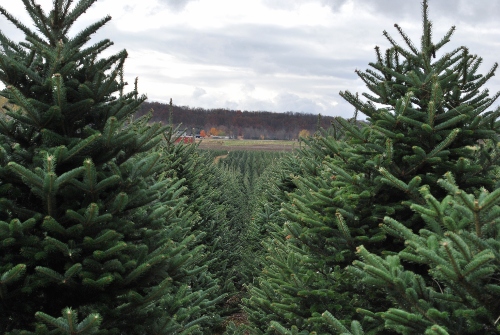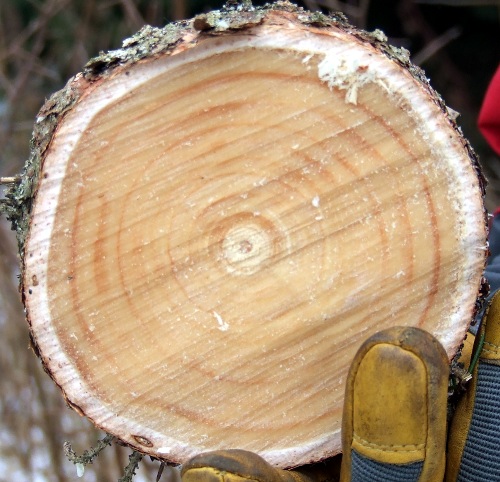Real Christmas trees: A natural choice
Choosing the right species of Christmas tree will give you lasting enjoyment through the holiday season.
With seasonal decorating underway, many are thinking about obtaining that American holiday icon, the Christmas tree. If there was concern last year about needles dropping all over the carpet coupled with memories of those prickly branches when you nestled gifts at the base, you may find yourself thinking, “We have this fresh tree – why?”
But as the holiday gets closer, few things can dim the excitement of traveling out to the neighborhood tree lot or to a local “choose and cut” tree farm. If these warm experiences coupled with the fragrance and look of a fresh tree are what’s driving you, you may want to think about a different kind of tree this year.
Prickly personality alternative
My holiday favorite has and always will be the Colorado blue spruce. When cut fresh, this naturally conical beauty will hold its needles for a fair amount of time and is stiff enough to hang even the heaviest family memorabilia. The down side of any spruce is touching the stiff, pointed needles as you decorate – ouch!
A softer and equally beautiful tree choice is the fir. With rounded tips on flat, pliable needles, coupled with the most intoxicating citrus scent, any variety you choose will sure to be a winner. When learning the two species in my college days, I recalled the adage, “If it’s a spruce let it loose – the fir is friendly!”

Few trees can match the beauty of a true fir. With rounded needles,
fingers will not be poked when decorating. Photo credit: Rebecca Finneran, MSUE
A look back
According to the Christmas tree experts at Michigan State University Extension, the iconic Scotch pine that made up between 80 to 90 percent in the 1980s now only makes up 25 percent of Michigan’s production.
Enter stage left the beautiful fir. For more than 10 years, over 30 different types of fir have been under evaluation in Michigan at the MSU Kellogg Biological Station to determine which clones of fir are best suited for our climate. This group of beauties can range from the deepest forest green foliage to lightly tinged blues. Many of the trees being evaluated are also U.S. natives, giving them a leg up on some clones that may not tolerate our dryer growing conditions. One of the best things about growing fir is their naturally “conical” shape and pest resistance, which requires fewer growing inputs, making them a “greener” choice for producers.

Firs grown at tree farm. Photo credit: Jill O’Donnell, MSUE
Other things have changed in our state as well. Growing holiday trees was once a bit of a “no-brainer” if you had some acreage available. “Horticulturally” speaking, the level of intensity in growing today’s trees has dramatically increased to stay profitable as well as “green.” Choosing pest resistant strains including fir is just one way growers are staying in touch with our state’s desire to reduce pesticide use and protect water quality.
Tips for tree toters
Regardless of what species you choose, when selecting your fresh tree, make sure the needles are soft and pliable. When you touch the branches, very few should fall off. (Every tree will shed some of the interior needles.)
The first thing you should do when you arrive home is re-trim the base and place the tree in water. If you aren’t going to decorate it right away, a water-filled bucket will do nicely. The tree can be placed in a cool garage until you take it indoors. With home temperatures in the high 60s, your tree will begin to transpire a fair amount of moisture out of its needles every day. A fresh cut tree can use up to a quart of water per inch of trunk diameter, so a tree with a 4-inch trunk can use up to a gallon in one day. Water immediately when you put it into the tree stand and be sure to top off the water each day. (For more information on watering your Christmas tree, see the related MSU Extension article The key to a fresh Christmas tree is water!)

Be sure to trim the base of your tree before you place it in the water-filled
tree stand. Photo credit: Rebecca Finneran, MSUE
Remember to display your tree in an area away from heat sources such as registers, radiators and fireplaces. We frequently use painter’s tape over the heat register closest to our tree. Use up-to-date lights with in-line fuses to avoid overloading and never display your tree near a fire source. Always turn off tree lights when away from home and before going to bed.
So get in the car and plan to make this holiday one to remember! With the many types of tree species available today, you may want to do some research before you go. You can log on to the National Christmas Tree Association for more information, and to get a list of Michigan retailers of fresh trees, visit the Michigan Christmas Tree Association website. You can also read related MSU Extension article from November 2011, Selecting your Christmas tree.
For more information on a wide variety of “Smart Garden” topics, visit the Gardening in Michigan website or contact MSU’s toll-free garden hotline at 1-888-678-3464 with any of your questions. Read MSU horticulture educator and garden columnist Rebecca Finneran’s blog.



 Print
Print Email
Email




